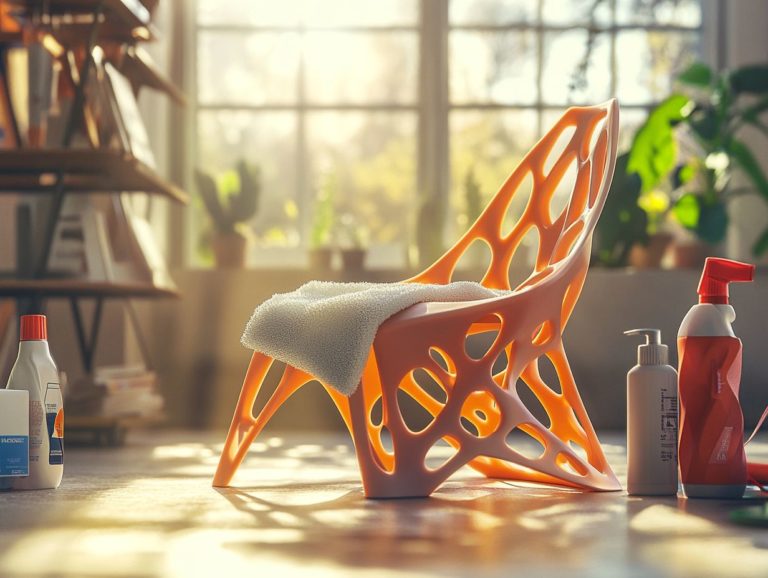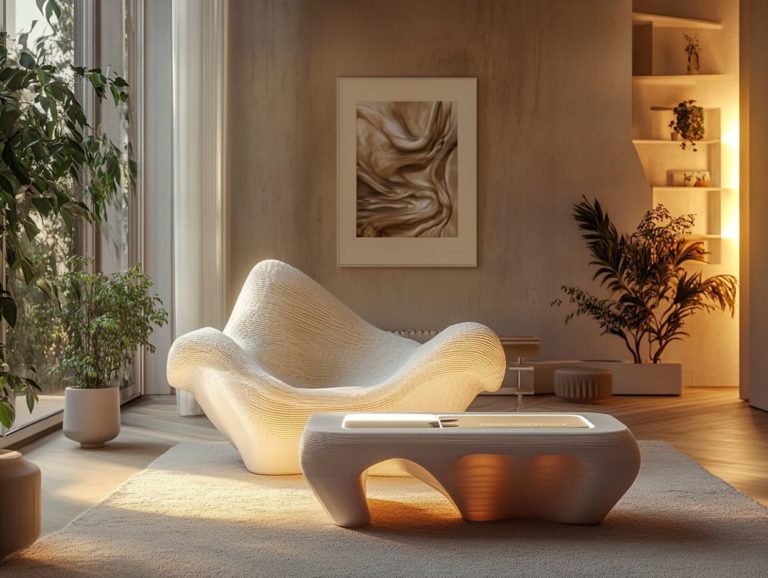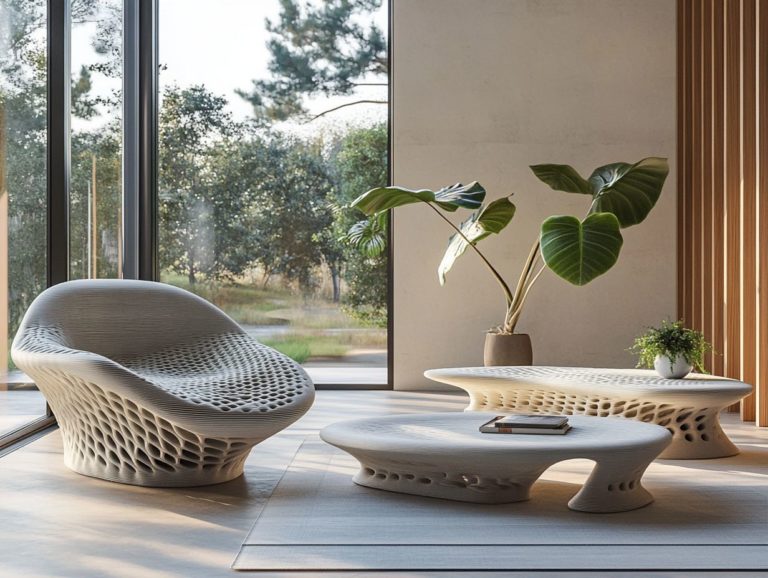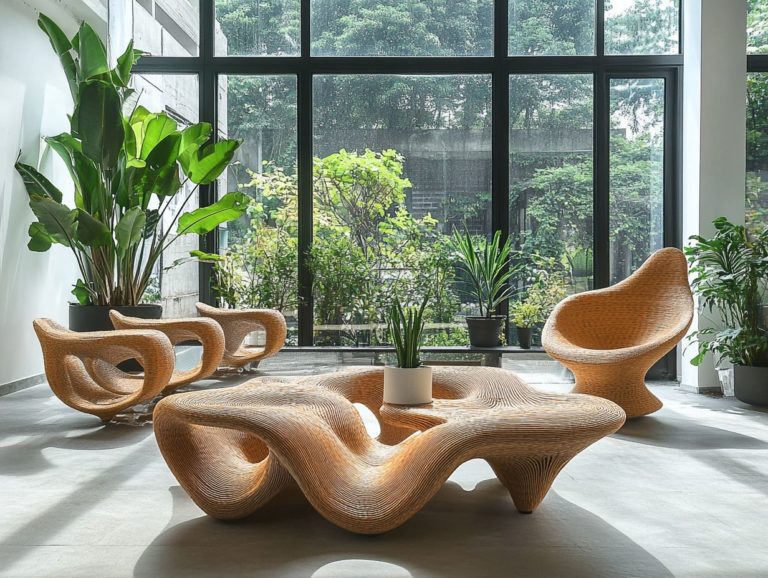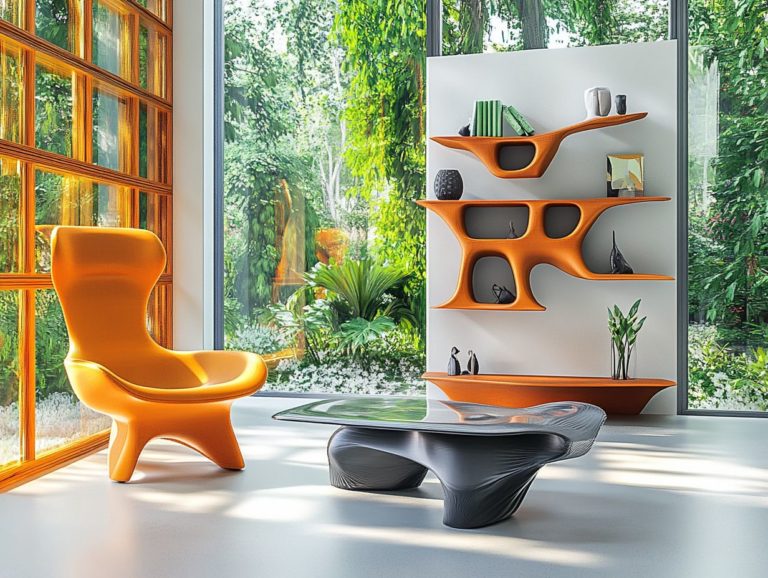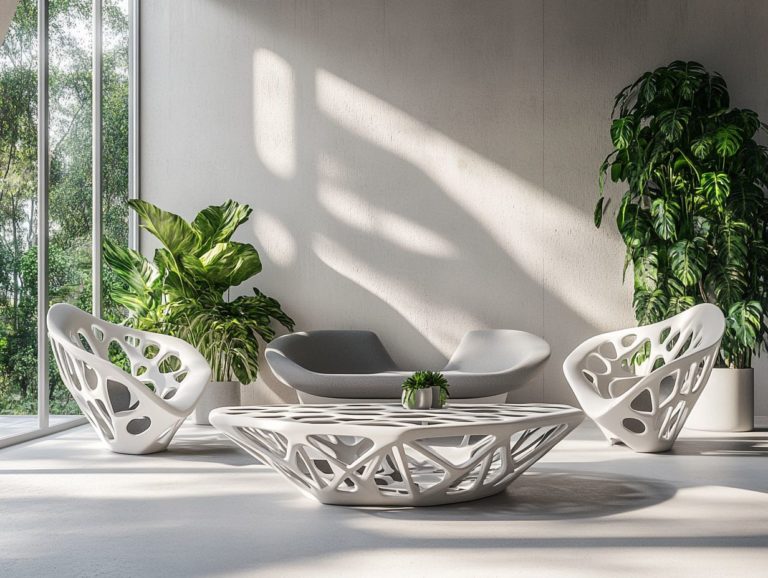5 Tips for Designing Your Own 3D-Printed Furniture
Designing your own 3D-printed furniture is an exhilarating journey that beautifully marries creativity with cutting-edge technology.
This guide presents five essential tips to navigate the process. It begins with the importance of crafting a comprehensive plan and exploring material experimentation.
It also explores the advantages and limitations of 3D-printed furniture. You will find outlines of the various printing technologies at your disposal and highlights of common pitfalls to steer clear of.
Whether you re an experienced designer or a curious newcomer, you ll uncover valuable insights to ignite inspiration for your next project.
Contents
- Key Takeaways:
- 1. Start with a Detailed Plan and Design
- 2. Choose the Right Material
- 3. Make Sure Your Design is Strong and Stable
- 4. Utilize Support Structures
- 5. Don’t Be Afraid to Experiment and Iterate
- What Is 3D Printing and How Does It Work?
- Frequently Asked Questions
- What are the benefits of designing my own 3D-printed furniture?
- Do I need any special skills or software to design 3D-printed furniture?
- What materials can be used for 3D-printed furniture?
- Are there any limitations to designing 3D-printed furniture?
- What are some important factors to consider when designing 3D-printed furniture?
- Do I need to have my own 3D printer to design my own furniture?
Key Takeaways:
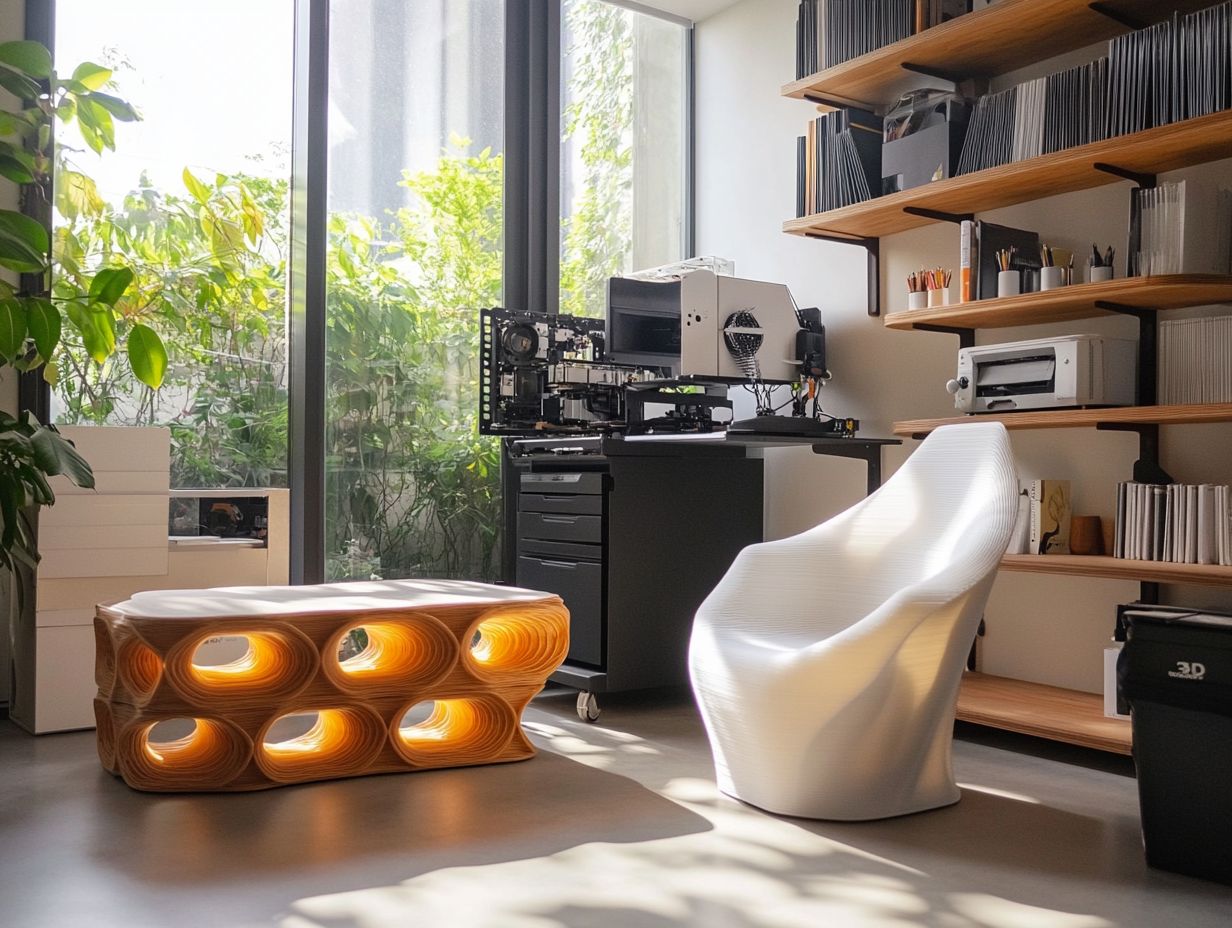
- Start with a detailed plan and design to ensure the success of your 3D-printed furniture project.
- Choose the right material to achieve the desired look, durability, and functionality of your furniture piece.
- Make sure your design is strong and stable to withstand everyday use and weight.
1. Start with a Detailed Plan and Design
A successful 3D printing project starts with a meticulous plan and design. This phase should integrate the unique needs of product innovators and industrial designers into the creative process.
This foundational work ensures that the final product meets your expectations for functionality. It should also delight in aesthetics while carefully considering essential parameters for achieving high print quality and efficient material use.
During planning, you have the opportunity to make thoughtful design choices. These choices can significantly influence the entire manufacturing timeline, ultimately ensuring timely completion of your project.
Using computer-aided design software helps create precise models that reflect your intended design. This reduces the likelihood of errors and the need for rework, enhancing collaboration among your team.
By optimizing the design workflow and focusing on essential features, you can streamline the transition from concept to final product. This strategy elevates both quality and efficiency throughout your 3D printing endeavors, setting you up for remarkable success.
2. Choose the Right Material
Choosing the right print material in 3D printing is crucial. Each filament type like PLA, ABS, Nylon, PETG, or TPU has its unique advantages and limitations tailored for specific applications.
Understanding these properties can significantly affect the longevity and functionality of your printed object. For instance, PLA is celebrated for its user-friendliness and solid strength, making it a great choice for newcomers.
ABS excels in heat resistance and flexibility, which is ideal for more demanding projects. Nylon impresses with its exceptional durability and flexibility, while PETG offers a blend of strength and ease of printing.
Then there’s TPU, which adds flexibility, making it perfect for projects that need a bit of stretch. Each material influences how strong and durable your print is and affects print speed and overall quality.
3. Make Sure Your Design is Strong and Stable
In 3D printing, ensuring structural integrity is essential. It profoundly impacts the durability and functionality of your printed model.
Pay careful attention to factors like wall thickness, overhangs, and infill patterns. A well-considered wall thickness not only strengthens your object but also affects its weight, which is crucial for applications requiring balance and support.
Choosing the right infill patterns determines your object’s stability. For example, a honeycomb structure provides excellent load distribution, while a grid pattern might suffice for lighter applications.
Consider adding extra reinforcement in areas prone to stress. Overhangs may require support structures to prevent sagging during printing. These considerations significantly influence both the longevity and performance of your print in real-world conditions.
4. Utilize Support Structures
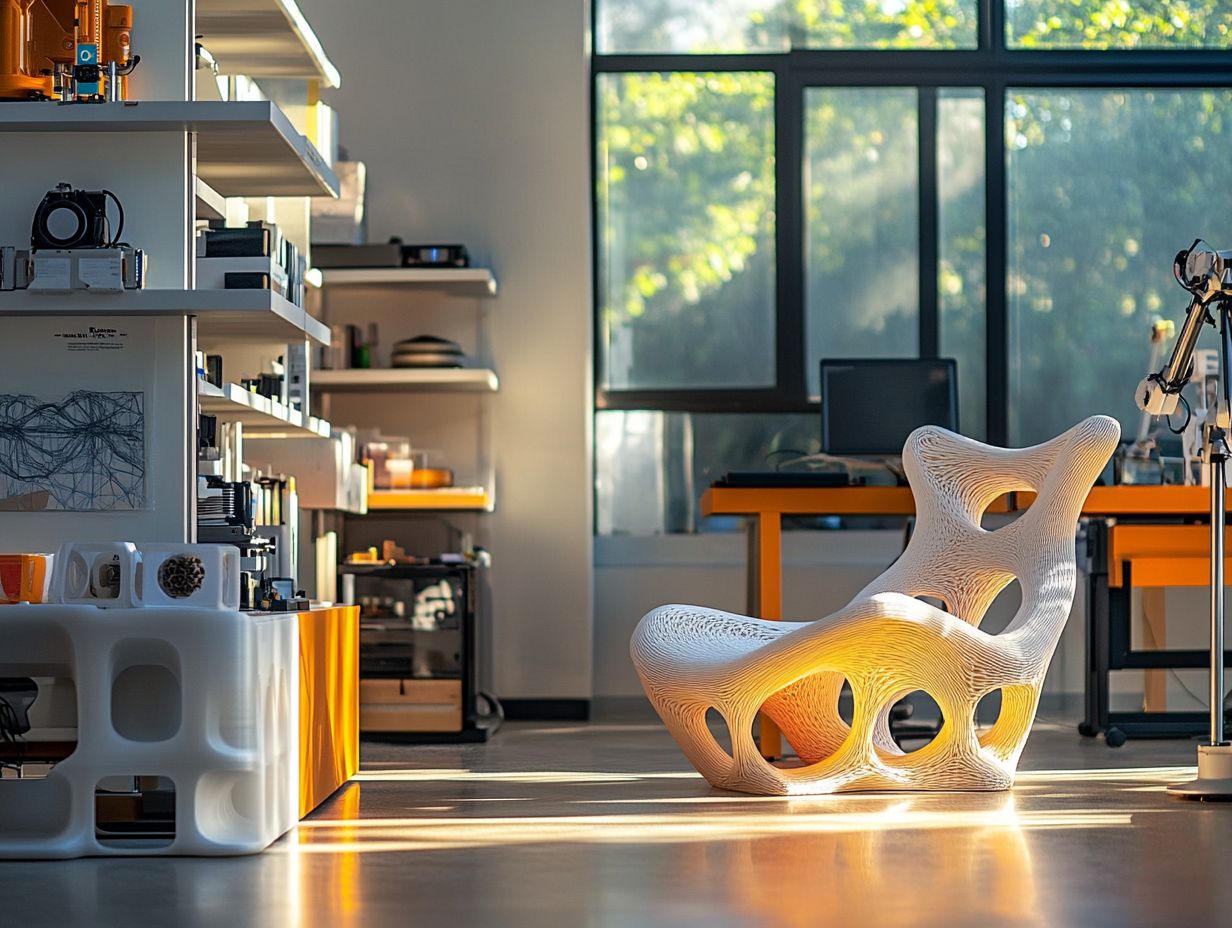
Utilizing support structures is essential in 3D printing. They enable the successful creation of complex shapes while effectively managing supports without sacrificing print quality.
You can select from various types of support structures, such as tree-like supports or traditional linear supports. These are designed to minimize material usage while maintaining the strength of your print. By analyzing the geometry you’re working with, you’ll find that alternative placements not only support overhangs but also help reduce waste.
The introduction of dual extrusion printers has transformed support management. These printers allow you to use one type of filament specifically for supports that can be easily removed. This breakthrough gives you a cleaner finish and minimizes post-processing efforts. With these advancements, proper planning and technology can significantly enhance your 3D printing workflow.
5. Don’t Be Afraid to Experiment and Iterate
Embracing an experimental mindset in 3D printing allows you to cultivate innovative designs and enhance functionality. This makes rapid prototyping essential for refining your ideas through iterative processes.
This approach encourages you to explore various techniques, such as adjusting extrusion profiles, which can elevate print quality. For example, adjusting the temperature and flow rate of the filament can lead to better layer adhesion, effectively reducing issues like warping or delamination.
Modifying print speed settings can also yield smoother finishes and finer details. This enables you to take on intricate designs that once seemed out of reach. Continuous experimentation not only hones these attributes but also plays a vital role in improving machine calibration for outputs that are both reliable and of exceptional quality.
What Is 3D Printing and How Does It Work?
-
3D printing, commonly known as additive manufacturing, is a revolutionary technology that allows you to create three-dimensional objects layer by layer from digital designs. Using methods like Fused Deposition Modeling (FDM), you can achieve remarkable precision in shapes.
-
The process starts by creating a detailed computer-aided design (CAD) model that serves as your blueprint. Once that’s ready, you’ll convert the CAD file into an STL (Stereolithography) format. This enables the software to slice the model into thin layers suitable for printing.
-
The motion platforms you choose are crucial in this operation. Systems like CoreXY are preferred for their efficiency and speed. These platforms use a dual-drive approach that reduces inertia, greatly enhancing both print accuracy and reliability perfect for complex designs and larger builds.
What Are the Advantages of 3D-Printed Furniture?
3D-printed furniture offers numerous advantages, including customization, swift prototyping, and the ability to create intricate designs that traditional manufacturing often struggles with, highlighting the unique benefits of 3D-printed furniture.
This modern approach allows you to tailor pieces to your unique preferences, resulting in furniture that fits seamlessly into your lifestyle and space. By leveraging rapid prototyping, you can quickly test and refine ideas, ensuring that both functionality and aesthetics harmonize.
Consider examples like the adaptive chair that adjusts to various postures or the elegant Hive table, known for its hexagonal design that balances form and function perfectly. These projects showcase how 3D printing elevates artistic expression and promotes sustainability by reducing waste in the design process.
What Are the Limitations of 3D-Printed Furniture?
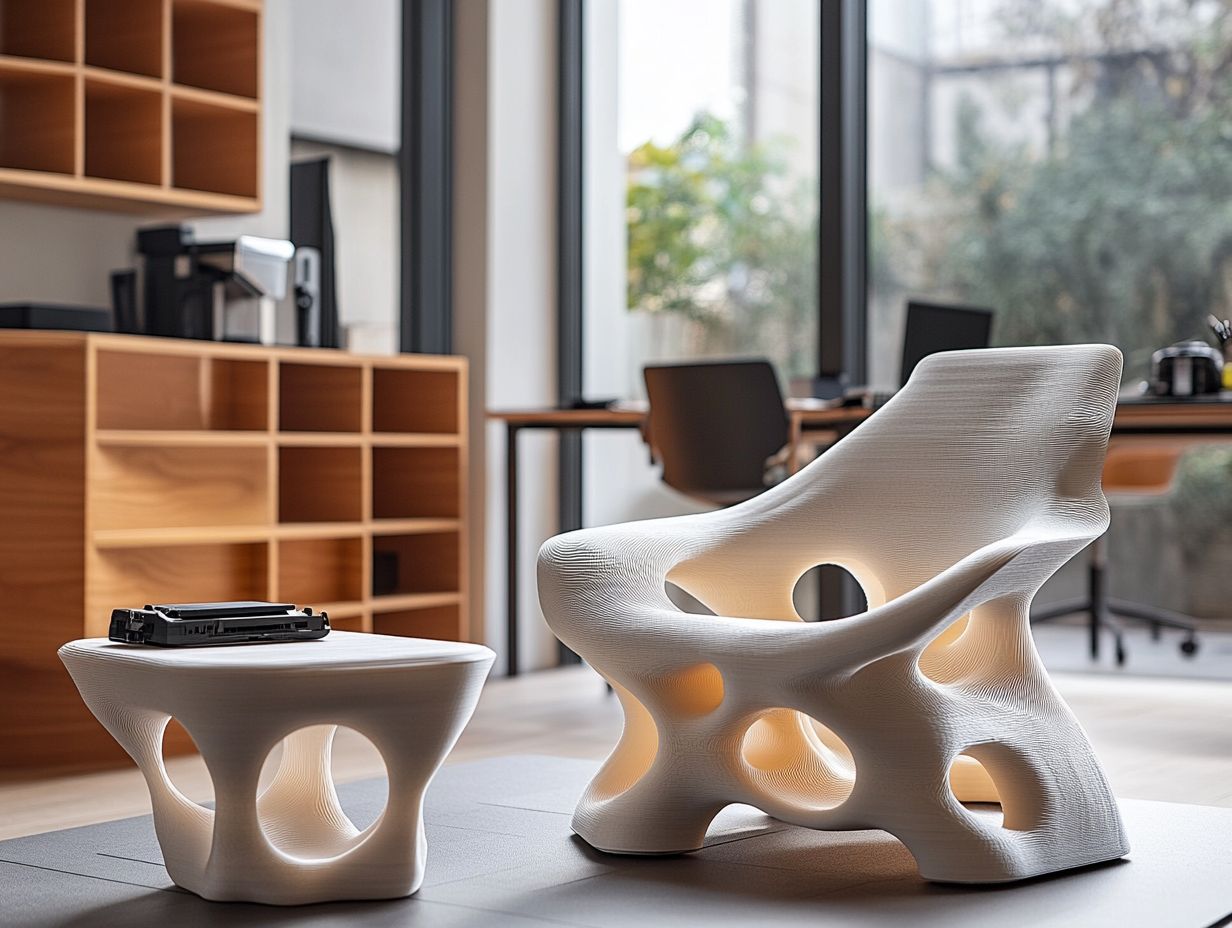
While 3D-printed furniture offers several enticing advantages, it also presents limitations you should be aware of, such as material restrictions and potential issues with print quality that could impact both durability and visual appeal. To stay informed, check out these trends in 3D-printed furniture.
These limitations can significantly affect your overall experience as a consumer. Issues like poor layer adhesion may create structural weaknesses in the pieces, jeopardizing not only their lifespan but also their visual integrity. Variations in surface finish can alter how the material looks under light, potentially leading to an unappealing look that detracts from the intended design.
As you seek out standout furniture options that will catch everyone s eye, any imperfections in print quality may hinder acceptance in the market. This makes it essential for designers and manufacturers to effectively tackle these challenges.
What Are the Different Types of 3D Printing Technologies?
You have a wealth of 3D printing technologies at your disposal, with Fused Deposition Modeling (FDM), Stereolithography (SLA), and Selective Laser Sintering (SLS) standing out as some of the most popular choices for various applications.
Each method possesses its own unique characteristics, making it suited for specific projects. FDM is your go-to for affordability and accessibility. It uses melted plastic to build items layer by layer, making it perfect for prototyping and functional parts.
On the flip side, SLA employs resin cured by UV light, resulting in highly detailed and smooth finishes, ideal for intricate designs like jewelry and dental products. SLS, armed with a powerful laser to fuse powdered materials, excels at producing robust and complex geometries perfect for both end-use products and tooling.
If you’re looking to elevate your FDM printing game, dual extrusion technologies are a game changer. They enable the creation of multicolor items or the integration of support materials, unlocking innovative design possibilities that were once out of reach.
How Can One Design Furniture for 3D Printing?
Designing furniture for 3D printing requires a thoughtful application of design principles and mastery of CAD software, allowing you to create models that are both functional and compatible with the nuances of the 3D printing process. By exploring ways 3D-printed furniture can save you money, you can enhance your design approach further.
To achieve stunning results, you must consider various factors, including geometric shapes, wall thickness, and the necessary support structures. When using CAD software, keeping shapes simple and streamlined is essential. A consistent wall thickness not only ensures durability but also optimizes material efficiency, helping you avoid unnecessary weight without sacrificing strength.
Understanding how different designs behave during the printing phase can greatly enhance the final output. Remember, prioritizing printability doesn t mean sacrificing aesthetics; with smart design choices, you can seamlessly integrate both functional requirements and visual appeal.
What Are Some Common Mistakes to Avoid When Designing 3D-Printed Furniture?
When you’re designing 3D-printed furniture, steering clear of common mistakes is crucial for achieving a successful outcome. To enhance your design, consider exploring 5 ways to personalize your 3D-printed furniture. Miscalculations in structural integrity and model features often lead to functional failures that can be easily avoided.
Take wall thickness, for instance. Overlooking this critical element can result in fragile pieces that simply won t hold up to regular use. Similarly, neglecting to incorporate adequate support structures can lead to sagging or breakage under weight, resulting in disappointing furniture. And let s not forget the implications of overhangs; ignoring them can lead to poor surface finishes and unbalanced designs, compromising both aesthetics and functionality.
By following best practices like conducting thorough stress analyses and choosing the right materials you can significantly enhance the durability and usability of your creations. This approach ultimately leads to a far more satisfying end product that you can be proud of.
Frequently Asked Questions
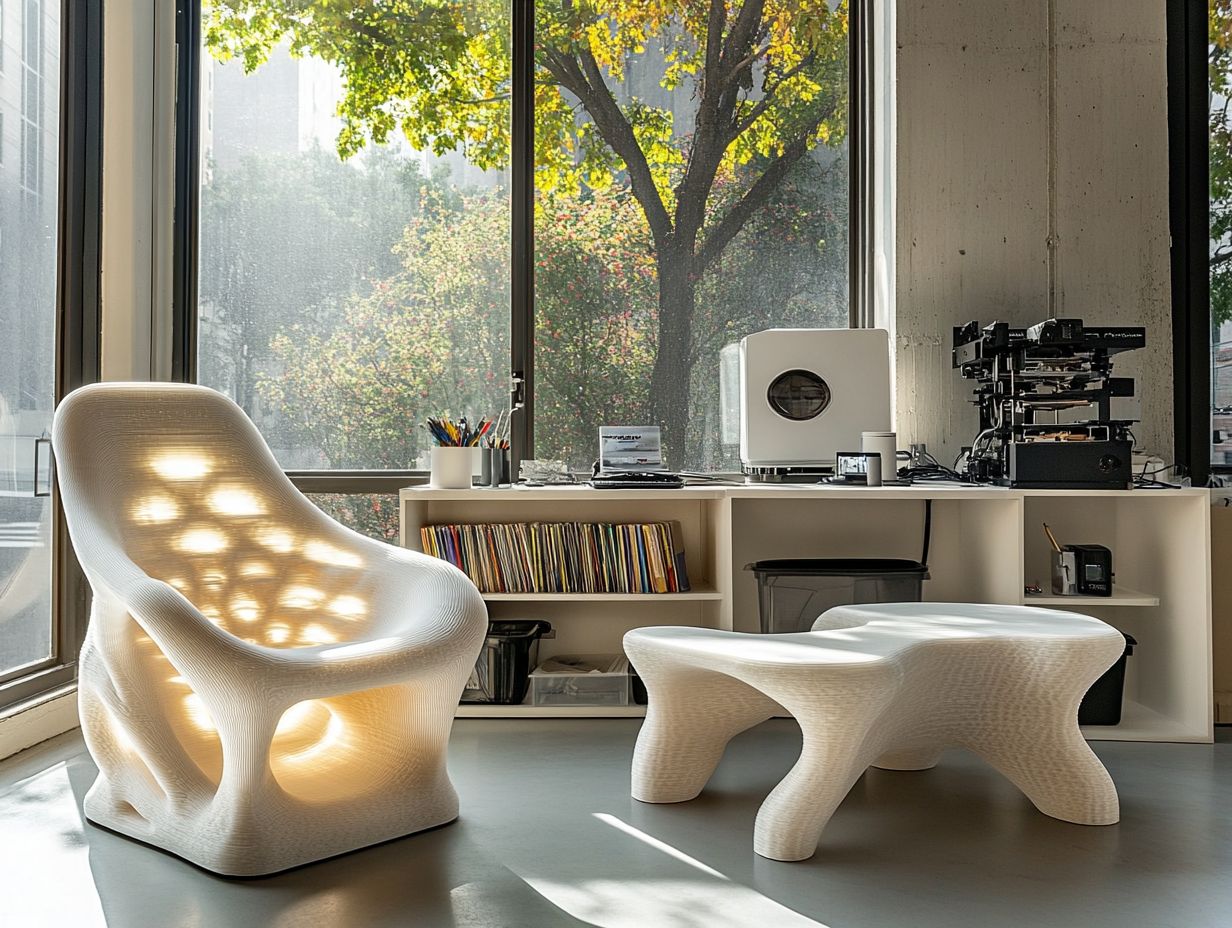
What are the benefits of designing my own 3D-printed furniture?
Designing your own 3D-printed furniture allows for a completely personalized and unique piece that perfectly fits your space and style. For tips on how to decorate with 3D-printed furniture, say goodbye to complicated assembly! Enjoy a seamless experience from design to finished product.
Additionally, this approach reduces material waste, making it a more eco-friendly option.
Do I need any special skills or software to design 3D-printed furniture?
While having experience with software that helps you create three-dimensional models can be helpful, there are many user-friendly programs available that make it easy for beginners. You can also find exciting pre-made templates and designs online. Start designing today!
What materials can be used for 3D-printed furniture?
You can use materials like plastic, wood, and metal for your 3D-printed furniture. To elevate your design, consider exploring how to incorporate 3D-printed furniture in your decor with unconventional options such as concrete, recycled materials, and even food-based materials like chocolate!
Are there any limitations to designing 3D-printed furniture?
While 3D printing technology has come a long way, some limitations remain. For example, the size and weight of the final product may be restricted by the dimensions of the 3D printer. Intricate designs may also pose challenges in terms of execution.
What are some important factors to consider when designing 3D-printed furniture?
When designing your own 3D-printed furniture, it’s crucial to consider factors such as functionality, durability, and aesthetics. Following the best practices for designing 3D-printed furniture will help ensure your design is practical and can withstand daily use while being visually appealing.
Do I need to have my own 3D printer to design my own furniture?
You don’t need to own a 3D printer to create your unique furniture. Many local makerspaces or businesses offer 3D printing services, or you can explore the process of creating 3D-printed furniture through online printing services to bring your design to life.

